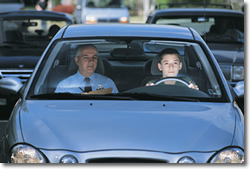Alcohol and Transportation Safety
Download PDF Version What is PDF?
Source: Alcohol Alert, a Journal of the National Institute on Alcohol Abuse and Alcoholism,
No. 52, April 2001
Public Domain
Table of Contents (TOC)
IntroductionChapter 1: BAC and Impairment
Chapter 2: Factors that Influence Alcohol-Induced Impairment
Chapter 3: Recent Declines in Drinking and Driving
Chapter 4: Prevention Strategies
Chapter 5: Reducing Repeated DUI offenses
Chapter 6: Alcohol and Transportation Safety: A Commentary
References
Research has shown that even low blood alcohol concentration (BAC)* impairs driving skills and increases crash risk. New information about BAC and impairment has led to policy changes, which have contributed to declines in alcohol-related crashes and fatalities. This Alcohol Alert examines some aspects of alcohol-induced impairment and reviews selected strategies designed to reduce alcohol-related crashes and repeat drinking-and-driving offenses.
 A review of 112 studies concluded that
certain skills required to operate essentially any type
of motorized vehicle become impaired at even modest departures
from zero BAC. At 0.05 percent BAC, most studies reported
significant impairment. By 0.08 percent BAC, 94 percent
of the studies reported impairment. Some skills are significantly
impaired at 0.01 percent BAC, although other skills do not
show impairment until 0.06 percent BAC.1 At BACs of 0.02
percent or lower, the ability to divide attention between
two or more sources of visual information can be impaired.
Starting at BACs of 0.05 percent, drivers show other types
of impairment, including eye movement, glare resistance,
visual perception, and reaction time. Moskowitz and colleagues2
reported that alcohol significantly impaired driving
simulator performance at all BACs starting at 0.02 percent.
A review of 112 studies concluded that
certain skills required to operate essentially any type
of motorized vehicle become impaired at even modest departures
from zero BAC. At 0.05 percent BAC, most studies reported
significant impairment. By 0.08 percent BAC, 94 percent
of the studies reported impairment. Some skills are significantly
impaired at 0.01 percent BAC, although other skills do not
show impairment until 0.06 percent BAC.1 At BACs of 0.02
percent or lower, the ability to divide attention between
two or more sources of visual information can be impaired.
Starting at BACs of 0.05 percent, drivers show other types
of impairment, including eye movement, glare resistance,
visual perception, and reaction time. Moskowitz and colleagues2
reported that alcohol significantly impaired driving
simulator performance at all BACs starting at 0.02 percent.
The risk of a fatal crash for drivers with positive BACs compared with other drivers (i.e., the relative risk) increases with increasing BAC, and the risks increase more steeply for drivers younger than age 21 than for older drivers.3 Between 0.08 and 0.10 percent BACs, the relative risk of a fatal single-vehicle crash varies between 11 percent (for drivers age 35 and older) and 52 percent (for male drivers ages 16-20).
Other forms of transportation also have been investigated. Studies using an automated device that simulates actual flight conditions have shown pilot performance to be impaired at BACs as low as 0.04 percent4, 5 and to remain impaired for as long as 14 hours after pilots reached BACs between 0.10 percent and 0.12 percent.4, 6 Another experiment using a simulated environment showed that experienced maritime academy students with BACs of 0.05 needed significantly more time than did other students to solve a problem related to power plant operation on board a merchant ship and were not aware of their impairment.7
Alcohol Tolerance. Research suggests that the repeated performance of certain tasks while under the influence of alcohol can make a person less sensitive to impairment at a given BAC. However, although impairment from alcohol may not be evident during routine tasks, performance would worsen in novel or unexpected situations.8
 Age. Based
on miles driven, the highest driver fatality rates are found
among the youngest and oldest drivers. Compared with the
fatality rate for drivers ages 25-69, the rate for 16- to
19-year-old drivers is about four times as high, and the
rate for drivers age 85 and older is nine times as high.9, 10 Among male drivers younger than age 21, a BAC increase
of 0.02 percent more than doubles the relative risk for
a single-vehicle fatal crash. Women in this age group, however,
have lower relative risk than do men at every BAC.3 Young
drivers’ greater crash risk is attributed, in part, to lack
of driving experience11 coupled with overconfidence.12
The presence of other teenagers in the car may encourage
risky driving and is associated with increased fatal crash
risk among young drivers.13
Age. Based
on miles driven, the highest driver fatality rates are found
among the youngest and oldest drivers. Compared with the
fatality rate for drivers ages 25-69, the rate for 16- to
19-year-old drivers is about four times as high, and the
rate for drivers age 85 and older is nine times as high.9, 10 Among male drivers younger than age 21, a BAC increase
of 0.02 percent more than doubles the relative risk for
a single-vehicle fatal crash. Women in this age group, however,
have lower relative risk than do men at every BAC.3 Young
drivers’ greater crash risk is attributed, in part, to lack
of driving experience11 coupled with overconfidence.12
The presence of other teenagers in the car may encourage
risky driving and is associated with increased fatal crash
risk among young drivers.13
Alcohol is less often a factor in crashes involving older drivers. In 1999 drivers age 65 and older killed in crashes were the least likely of any adult age group to have positive BACs.14 Nevertheless, a person’s crash risk per mile increases starting at age 55 and exceeds that of a young, beginning driver by age 80.15 Factors associated with unsafe driving include problems with vision, attention, perception, and cognition.16, 17 Older drivers with alcoholism also are more vulnerable than are other elderly drivers to impairment and have greater crash risks.15
Sleep Deprivation. Drowsiness increases crash risk, and research shows that BACs as low as 0.01 percent increase susceptibility to sleepiness.1 Alcohol consumption also increases the adverse effects of sleep deprivation. Subjects given low doses of alcohol following a night of reduced sleep perform poorly in a driving simulator, even with no detectable alcohol in the blood.18, 19
Research shows that drinking and driving in the United States has decreased over the past decade, especially among young drivers. The proportion of all traffic fatalities that are alcohol related has decreased. The overall percentage of drivers with positive BACs among all drivers surveyed on weekend nights also has decreased. In addition, crash statistics and driver surveys both show decreases in the proportion of drivers with BACs of 0.10 percent or higher, with the largest decreases among drivers younger than age 21.20, 21
Raising the Minimum Legal Drinking Age (MLDA). The National Highway Traffic Safety Administration (NHTSA) estimates that raising the MLDA to 21 has reduced traffic fatalities involving 18- to 20-year-old drivers by 13 percent and has saved an estimated 19,121 lives since 1975. Twenty of twenty-nine studies conducted between 1981 and 1992 reported significant decreases in traffic crashes and crash fatalities following an increase in MLDA. Three studies found no change in traffic crashes involving youth in various age groups, and six studies had mixed results.22 Laws that prohibit selling or providing alcohol to minors generally are not well enforced, but community efforts to increase MLDA enforcement can be effective.23, 24
 Zero-Tolerance
Laws. These laws, which set the legal BAC limit
for drivers younger than age 21 at 0.00 or 0.02 percent,
have been associated with 20 percent declines in the
proportion of drinking drivers involved in fatal crashes
who are younger than age 2125 and in the proportion
of single-vehicle, nighttime fatal crashes among drivers
younger than age 21.26 Based on driver surveys, researchers
have reported that young drivers may be more successful
than are older drivers in separating drinking from driving,
and these researchers have suggested that this difference
could be attributable to zero-tolerance laws.27
Zero-Tolerance
Laws. These laws, which set the legal BAC limit
for drivers younger than age 21 at 0.00 or 0.02 percent,
have been associated with 20 percent declines in the
proportion of drinking drivers involved in fatal crashes
who are younger than age 2125 and in the proportion
of single-vehicle, nighttime fatal crashes among drivers
younger than age 21.26 Based on driver surveys, researchers
have reported that young drivers may be more successful
than are older drivers in separating drinking from driving,
and these researchers have suggested that this difference
could be attributable to zero-tolerance laws.27
BAC Laws That Lower Limits to 0.08 percent. The majority of States are now considering lowering the legal BAC limit for noncommercial drivers age 21 and older to 0.08 percent. In fact, according to NHTSA, 27 States have now approved legislation to lower BAC limits to 0.08 percent. Laws lowering the legal BAC limit for adult drivers to 0.08 percent are associated with declines in alcohol-related fatal crashes. One national study reported that States with 0.08 laws had smaller proportions of adult drivers in fatal crashes with BACs of 0.01-0.09 percent and with BACs of 0.10 percent and higher.28
Lower BAC Limits for DUI Offenders and Transportation Workers. In Maine, a law lowering the legal BAC limit to 0.05 percent for anyone convicted of driving under the influence (DUI) has been found to reduce significantly the number of fatal crashes among this population.29 Because drinking and driving by transportation workers threatens public safety, the Federal Government prohibits commercial truck drivers, railroad and mass transit workers, maritime employees, and aircraft pilots from operating their vehicles with BACs of 0.04 percent or higher.
Communitywide Prevention. Comprehensive community initiatives to reduce drinking and driving combine the efforts of public agencies and private citizens in implementing strategies, including media campaigns, police training, high school and college prevention programs, and increased liquor outlet surveillance. Such strategies have been found to reduce fatal crashes, alcohol-related fatal crashes, and traffic injuries.30, 31
 A community program in
San Diego was implemented to reduce the binge drinking and
impaired driving that result when young people cross the
U.S.-Mexico border to drink in Tijuana, where the legal
drinking age is 18 and beverage prices are lower. Researchers
estimated that more than 250 drivers with BACs of 0.08 percent
or higher on U.S. roads every Friday and Saturday night
are border-crossers.32 Targeted enforcement was found
to reduce the number of late-night crossers by 26 percent.33
A community program in
San Diego was implemented to reduce the binge drinking and
impaired driving that result when young people cross the
U.S.-Mexico border to drink in Tijuana, where the legal
drinking age is 18 and beverage prices are lower. Researchers
estimated that more than 250 drivers with BACs of 0.08 percent
or higher on U.S. roads every Friday and Saturday night
are border-crossers.32 Targeted enforcement was found
to reduce the number of late-night crossers by 26 percent.33
Alcohol Screening and Brief Intervention for Emergency Room Patients. Emergency room patients injured in alcohol-related crashes may have an increased motivation to change their drinking behavior.34 Emergency room interventions have been shown to reduce future drinking and trauma re-admission35 as well as drinking and driving, traffic violations, alcohol-related injuries, and alcohol-related problems among 18- and 19-year-olds.36
License Suspension. Laws that allow for administrative license suspension (ALS) at the time of arrest have been found to reduce both alcohol-related fatal crashes28, 37 and repeat DUI offenses.38 A study of an Ohio ALS law found that first-time and repeat DUI offenders who had their licenses immediately confiscated had significantly lower rates of DUI offenses, moving violations, and crashes during the next 2 years compared with DUI offenders convicted before the ALS law went into effect.38
 Although research shows that
license suspension reduces repeat DUI offenses, there
is also evidence that up to 75 percent of suspended
drivers continue to drive. Evaluation of Oregon’s "zebra
sticker" law suggests that marking the license plates
of vehicles driven by unlicensed drivers deters both
driving while suspended (DWS) and DUI by suspended
drivers. A similar law in Washington State was enforced
differently and had no effect.39
Although research shows that
license suspension reduces repeat DUI offenses, there
is also evidence that up to 75 percent of suspended
drivers continue to drive. Evaluation of Oregon’s "zebra
sticker" law suggests that marking the license plates
of vehicles driven by unlicensed drivers deters both
driving while suspended (DWS) and DUI by suspended
drivers. A similar law in Washington State was enforced
differently and had no effect.39
Vehicle Impoundment/Immobilization. Two studies of an Ohio law that allowed for vehicle immobilization40 or impoundment41 for multiple DUI offenders both found that offenders whose vehicles were immobilized or impounded had lower recidivism rates compared with other offenders while their vehicles were not available and after they were returned.
Other Prevention Strategies. Alcohol ignition interlocks-breath-testing devices designed to prevent operation of a vehicle if the driver’s BAC is above a predetermined low level-are used in some jurisdictions as an alternative to full license suspension. Research suggests that offenders who have interlocks installed have lower recidivism rates while the device is in use, but that recidivism rates rise after interlock removal.42, 43 Conversely, a few studies have reported that recidivism was significantly reduced both during interlock installation and after removal.44, 45
At victim impact panels, drinking-and-driving offenders must listen to persons who were injured or who lost a loved one in an alcohol-related crash recount the event’s impact on their lives. The effects of victim impact panels on recidivism have been mixed.46, 47, 48
by NIAAA Director Enoch Gordis, M.D.
At what blood alcohol level (BAC) are individuals too impaired to drive a car safely? In the United States, the BAC limit for driving a car in many States is 0.10 percent. The United States, in fact, is the only industrialized nation to have a BAC limit this high. A large body of creditable research over many years has clearly shown that impairment of tasks necessary for safe driving begins at levels as low as 0.05 percent. At the 0.08 percent BAC level, currently under consideration in many States, individuals are significantly impaired and at risk for causing harm to themselves and others. To date, 27 States have lowered the legal BAC limit to 0.08 percent. In many of the States that still maintain the higher 0.10 percent BAC, debates about lowering it often have had little to do with scientific soundness focusing, instead, on arguments that lower BAC limits infringe on the public’s right to drink socially. This argument has no merit; a 160-pound man generally will have reached only a BAC of approximately 0.04 percent 1 hour after consuming two 12-ounce beers or two other standard drinks on an empty stomach. Until these debates consider the actual, rather than the perceived, results of lowered BACs, we all run the risk of being injured or killed in automobile crashes due to drivers who are significantly-but not legally-impaired.
*BAC is the proportion of alcohol to blood in the body. In the field of traffic safety, BAC is expressed as a percentage reflecting grams of alcohol per deciliter of blood-for example, 0.10 percent is equivalent to 0.10 grams per deciliter.
(1) Moskowitz, H., and Fiorentino, D. A Review of the Literature on the Effects of Low Doses of Alcohol on Driving-Related Skills. Washington, DC: National Highway Traffic Safety Administration (NHTSA), 2000.
(2) Moskowitz, H.; Burns, M.; Fiorentino, D.; Smiley, A.; and Zador, P. Driver Characteristics and Impairment at Various BACs. Washington, DC: NHTSA, 2000.
(3) Zador P.L.; Krawchuk S.A.; and Voas R.B. Alcohol-related relative risk of driver fatalities and driver involvement in fatal crashes in relation to driver age and gender: An update using 1996 data. J Stud Alcohol 61:387-395, 2000.
(4) Morrow, D.; Leirer, V.; and Yesavage, J. The influence of alcohol and aging on radio communication during flight. Aviat Space Environ Med 61(1):12-20, 1990.
(5) Ross, L.E.; Yeazel, L.M.; and Chau, A.W. Pilot performance with blood alcohol concentrations below 0.04%. Aviat Space Environ Med 63(11):951-956, 1992.
(6) Yesavage, J.A., and Leirer, V.O. Hangover effects on aircraft pilots 14 hours after alcohol ingestion: A preliminary report. Am J Psychiatry 143(12):1546-1550, 1986.
(7) Howland, J.; Rohsenow, D.J.; Cote, J.; Siegel, M.; and Mangione, T.W. Effects of low-dose alcohol exposure on simulated merchant ship handling power plant operation by maritime cadets. Addict 95(5):719-726, 2000.
(8) Vogel-Sprott, M. Alcohol Tolerance and Social Drinking: Learning the Consequences. New York: Guilford Press, 1992.
(9) NHTSA. Traffic Safety Facts 1999: Older Population. Washington, DC: NHTSA, 2000.
(10) NHTSA. Traffic Safety Facts 1999: Young Drivers. Washington, DC: NHTSA, 2000.
(11) Mayhew, D.R.; Donelson, A.C.; Beirness, D.J.; and Simpson, H.M. Youth, alcohol and relative risk of crash involvement. Accid Anal Prev 18(4):273-287, 1986.
(12) Jonah, B.A. Accident risk and risk-taking behaviour among young drivers. Accid Anal Prev 18(4):255-271, 1986.
(13) Preusser, D.F.; Ferguson, S.A.; and Williams, A.F. Effect of teenage passengers on the fatal crash risk of teenage drivers. Accid Anal Prev 30(2):217-222, 1998.
(14) NHTSA. Traffic Safety Facts 1999. Washington, DC: NHTSA, 2000.
(15) Waller, P.F. Alcohol, aging, and driving. In: Gomberg, E.S.L.; Hegedus, A.M.; and Zucker, R.A., ed. Alcohol Problems and Aging. NIAAA Research Monograph No. 33. NIH Pub. No. 98-4163. Bethesda, MD: NIAAA, 1998.
(16) McGwin, G.; Chapman, V.; and Owsley, C. Visual risk factors for driving difficulty among older drivers. Accid Anal Prev 32:735-744, 2000.
(17) McKnight, A.J., and Lange, J.E. Automated screening techniques for drivers with age-related ability deficits. In: 41st Annual Proceedings: Association for the Advancement of Automotive Medicine. Des Plaines, IL: Association for the Advancement of Automotive Medicine (AAAM), 1997.
(18) Roehrs, T.; Beare, D.; Zorick, F.; and Roth, T. Sleepiness and ethanol effects on simulated driving. Alcohol Clin Exp Res 18(1):154-158, 1994.
(19) Krull, K.R.; Smith, L.T.; Sinha, R.; and Parsons, O.A. Simple reaction time event-related potentials: Effects of alcohol and sleep deprivation. Alcohol Clin Exp Res 17(4):771-777, 1993.
(20) NHTSA. Traffic Safety Facts 1999: Alcohol. National Center for Statistics and Analysis. Washington, DC: NHTSA, 2000.
(21) Voas, R.B.; Wells, J.K.; Lestina, D.C.; Williams, A.F.; and Greene, M.A. Drinking and Driving in the U.S.: The 1996 National Roadside Survey. NHTSA Traffic Task No. 152. Arlington, VA: Insurance Institute for Highway Safety, 1997.
(22) Toomey, T.L.; Rosenfeld, C.; and Wagenaar, A.C. The minimum legal drinking age: History, effectiveness, and ongoing debate. Alcohol Health Res World 20(4):213-218, 1996.
(23) Wagenaar, A.C.; Murray, D.M.; Gehan, J.P.; et al. Communities mobilizing for change on alcohol: Outcomes from a randomized community trial. J Stud Alcohol 61(1):85-94, 2000.
(24) Holder, H.D.; Saltz, R.F.; Grube, J.W.; et al. Summing up: Lessons from a comprehensive community prevention trial. Addict 92(Suppl. 2):S293-S301, 1997.
(25) Voas, R.B.; Lange, J.E.; and Tippetts, A.S. Enforcement of the zero tolerance law in California: A missed opportunity? In: 42nd Annual Proceedings: Association for the Advancement of Automotive Medicine. Des Plaines, IL: AAAM, 1998.
(26) Hingson, R.; Heeren, T.; and Winter, M. Lower legal blood alcohol limits for young drivers. Public Health Rep 109(6):738-744, 1994.
(27) Roeper, P.J., and Voas, R.B. Underage drivers are separating drinking from driving. Am J Public Health 89(5):755-757, 1999.
(28) Voas, R.B.; Tippets, A.S.; and Fell, J. The relationship of alcohol safety laws to drinking drivers in fatal crashes. Accid Anal Prev 32:483-492, 2000.
(29) Hingson, R.; Heeren, T.; and Winter, M. Effects of Maine’s 0.05% legal blood alcohol levels for drivers with DWI convictions. Public Health Rep 113(5):440-446, 1998.
(30) Hingson, R.; McGovern, T.; Howland, J.; et al. Reducing alcohol impaired driving in Massachusetts: The Saving Lives Program. Am J Public Health 86(6):791-797, 1996.
(31) Roeper, P.J.; Voas, R.B.; Padilla-Sanchez, L.; and Esteban, R. A long-term community-wide intervention to reduce alcohol related traffic injuries: Salinas, California. Drugs Educ Prev Policy 7(1)51-60, 2000.
(32) Lange, J.E., and Voas, R.B. Youth escaping limits on drinking: Binging in Mexico. Addict 95(4):521-528, 2000.
(33) Voas, R.B.; Lange, J.; Tippetts, A.S.; and Johnson, M. "Operation Safe Crossing: Using Science Within a Community Intervention." Paper presented at the 15th International Conference on Alcohol, Drugs and Traffic Safety in Stockholm, Sweden, on May 22-26, 2000.
(34) DiClemente, C.C.; Bellino, L.E.; and Neavins, T.M. Motivation for change and alcoholism treatment. Alcohol Res Health 23(2):86-92, 1999.
(35) Gentilello, L.M.; Rivara, F.P.; Donovan, D.M.; et al. Alcohol interventions in a trauma center as a means of reducing the risk of injury recurrence. Ann Surg 230(4):473-483, 1999.
(36) Monti, P.M.; Colby, S.M.; Barnett, N.P.; et al. Brief intervention for harm reduction with alcohol-positive older adolescents in a hospital emergency department. J Consult Clin Psychol 67(6):989-994, 1999.
(37) Zador, P.L.; Lund, A.K.; Fields, M.; and Weinberg, K. Fatal Crash Involvement and Laws Against Alcohol-Impaired Driving. Arlington, VA: Insurance Institute for Highway Safety, 1988.
(38) Voas, R.B.; Tippetts, A.S.; and Taylor, E.P. Impact of Ohio administrative license suspension. In: 42nd Annual Proceedings: Association for the Advancement of Automotive Medicine. Des Plaines, IL: AAAM, 1998.
(39) Voas, R.B.; Tippetts, A.; and Lange, J. Evaluation of a method for reducing unlicensed driving: The Washington and Oregon license plate sticker laws. Accid Anal Prev 29(5):627-634, 1997.
(40) Voas, R.B.; Tippetts, A.S.; and Taylor, E. Temporary vehicle immobilization: Evaluation of a program in Ohio. Accid Anal Prev 29(5):635-642, 1997.
(41) Voas, R.; Tippetts, A.; and Taylor, E. Temporary vehicle impoundment in Ohio: A replication and confirmation. Accid Anal Prev 30(5):651-656, 1998.
(42) Voas, R.B.; Marques, P.R.; Tippetts, A.S.; and Beirness, D.J. Alberta Interlock Program: The evaluation of a province-wide program on DUI recidivism. Addict 94(12):1849-1859, 1999.
(43) Tashima, H.N., and Helander, C.J. 1999 Annual Report of the California DUI Management Information System. Sacramento, CA: California Department of Motor Vehicles Research and Development Section, 1999.
(44) Weinrath, M. Ignition interlock program for drunk drivers: A multivariate test. Crime Delinquency 43(1):42-59, 1997.
(45) Beck, K.H.; Rauch, W.J.; Baker, E.A.; and Williams, A.F. Effects of ignition interlock license restrictions on drivers with multiple alcohol offenses: A randomized trial in Maryland. Am J Public Health 89(11):1696-1700, 1999.
(46) Shinar, D., and Compton, R.P. Victim impact panels: Their impact on DWI recidivism. Alcohol Drugs Driv 11(1):73-87, 1995.
(47) Fors, S.W., and Rojek, D.G. The effect of victim impact panels on DUI/DWI rearrest rates: A twelve-month follow-up. J Stud Alcohol 60(4):514-520, 1999.
(48) C’de Baca, J.; Lapham, S.C.; Paine, S.; and Skipper, B.J. Victim impact panels: Who is sentenced to attend? Does attendance affect recidivism of first-time DWI offenders? Alcohol Clin Exp Res 24(9):1420-1426, 2000.


